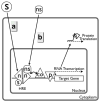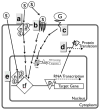Oestrogen and progesterone action on endometrium: a translational approach to understanding endometrial receptivity
- PMID: 23933037
- PMCID: PMC3818404
- DOI: 10.1016/j.rbmo.2013.06.010
Oestrogen and progesterone action on endometrium: a translational approach to understanding endometrial receptivity
Abstract
Embryo attachment and implantation is critical to successful reproduction of all eutherian mammals, including humans; a better understanding of these processes could lead to improved infertility treatments and novel contraceptive methods. Experience with assisted reproduction, especially oocyte donation cycles, has established that despite the diverse set of hormones produced by the ovary in a cycle-dependent fashion, the sequential actions of only two of them, oestrogen and progesterone, are sufficient to prepare a highly receptive endometrium in humans. Further investigation on the endometrial actions of these two hormones is currently providing significant insight into the implantation process in women, strongly suggesting that an abnormal response to progesterone underlies infertility in some patients.
Keywords: embryo implantation; endometrium; oestradiol; progesterone.
Copyright © 2013 Reproductive Healthcare Ltd. Published by Elsevier Ltd. All rights reserved.
Conflict of interest statement
Declaration: The author reports no financial or commercial conflicts of interest.
Figures



References
-
- Allen E, Doisey EA. An ovarian hormone: preliminary report on its localizaton, extraction and partial purification, and action in test animals. J Amer Med Asso. 1923;81:819–821. - PubMed
-
- Allen WM, Corner GW. Physiology of the corpus luteum. III. Normal growth and implantation of embryos after very early ablation of the ovaries, under the influence of extracts of the corpus luteum. Am J Physiol. 1929;88:340.
-
- Attia GR, Zeitoun K, Edwards D, Johns A, Carr BR, Bulun SE. Progesterone receptor isoform A but not B is expressed in endometriosis. J Clin Endocrinol Metab. 2000;85(8):2897–2902. - PubMed
Publication types
MeSH terms
Substances
Grants and funding
LinkOut - more resources
Full Text Sources
Other Literature Sources

